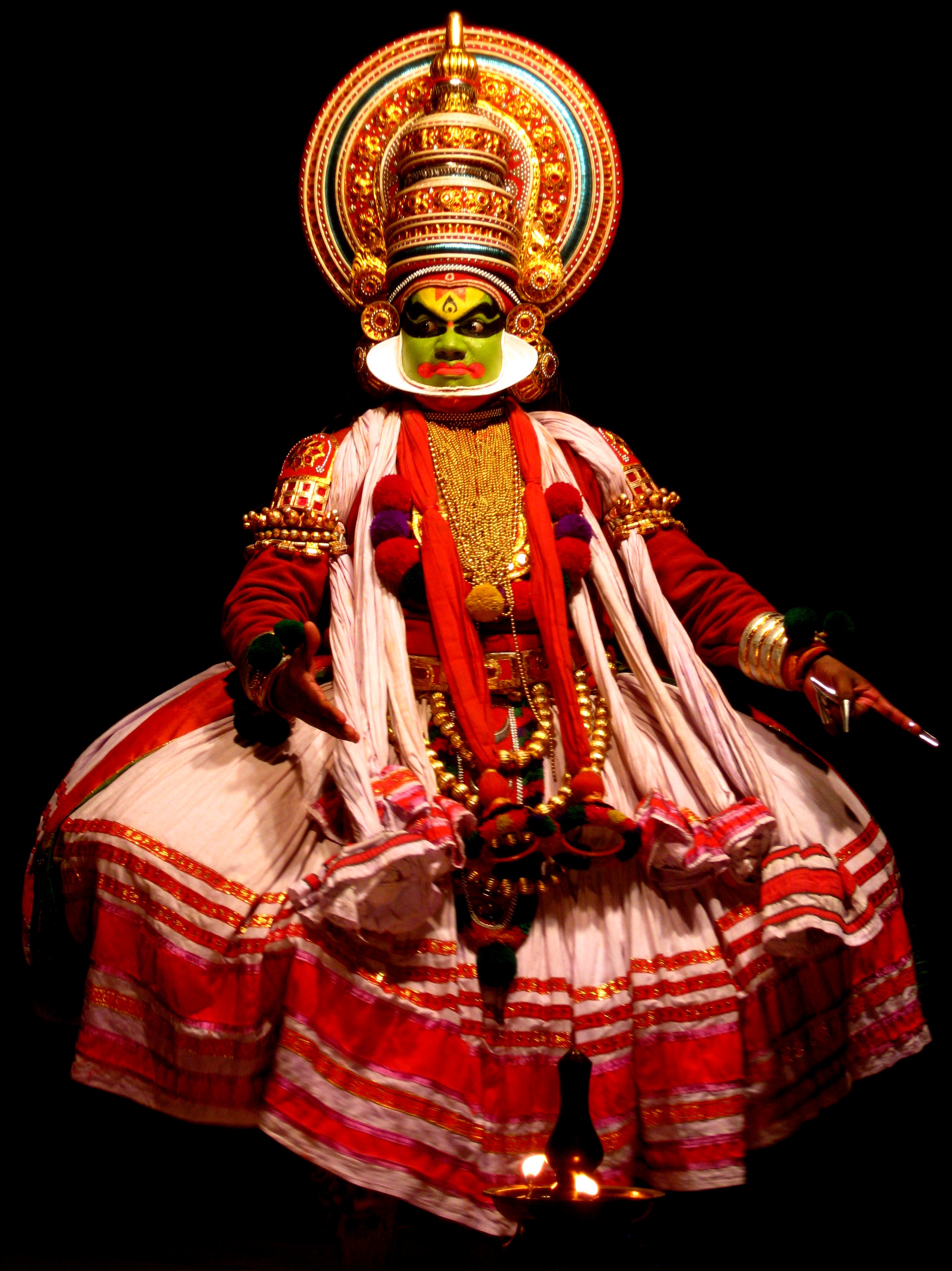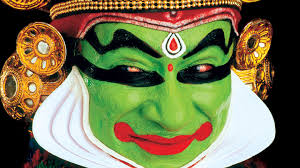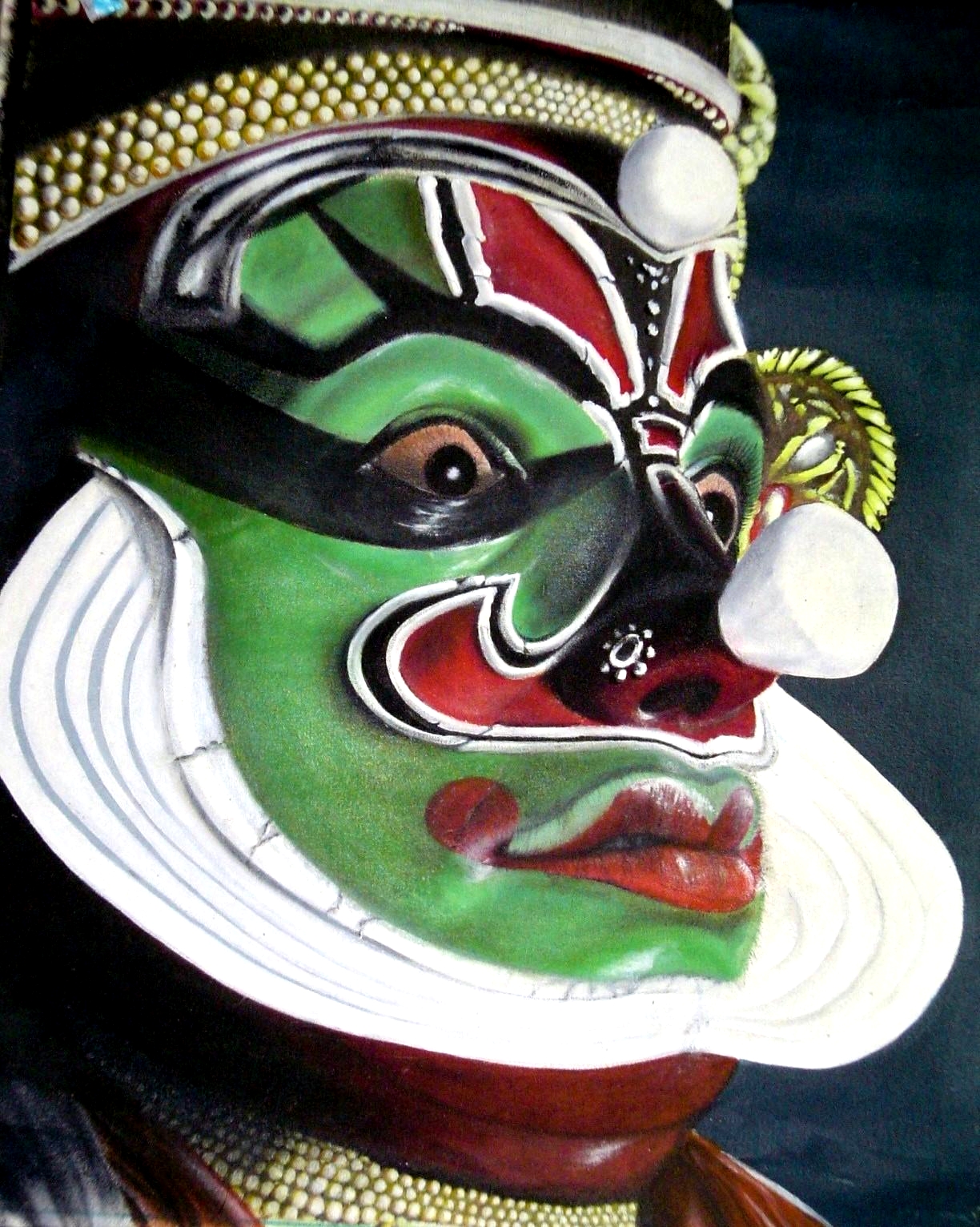Dance India
Helping dancers stay inspired...
Kathakali
Kathakali (Malayalam: കഥകളി, kathakaḷi; Sanskrit: कथाकळिः, kathākaḷiḥ) is a stylized classical Indian dance-drama noted for the attractive make-up of characters, elaborate costumes, detailed gestures and well-defined body movements presented in tune with the anchor playback music and complementary percussion. It originated in the country's present day state of Kerala during the 17th century and has developed over the years with improved looks, refined gestures and added themes besides more ornate singing and precise drumming.
History
Popular belief is that kathakali is emerged from "Krishnanattam", the dance drama on the life and activities of Lord Krishna created by Sri Manavedan Raja, the Zamorin of Calicut (1585-1658 AD). Once Kottarakkara Thampuran, the Raja of Kottarakkara who was attracted by Krishnanattam requested the Zamorin for the loan of a troupe of performers. Due to the political rivalry between the two, Zamorin did not allow this. So Kottarakkara Thampuran created another art form called Ramanattam which was later transformed into Aattakatha. Krishnanaattam was written in Sanskrit, and Ramanattam was in Malayalam. By the end of 17th century, Attakatha was presented to the world with the title 'Kathakali'. Kathakali also shares a lot of similarities with Krishnanattam, Koodiyattam (a classical Sanskrit drama existing in Kerala) and Ashtapadiyattam (an adaptation of 12th-century musical called Gitagovindam). It also incorporates several other elements from traditional and ritualistic art forms like Mudiyettu, Thiyyattu, Theyyam and Padayani besides a minor share of folk arts like Porattunatakam. All along, the martial art of Kalarippayattu has influenced the body language of Kathakali. The use of Malayalam, the local language (albeit as a mix of Sanskrit and Malayalam, called 'Manipravaalam'), has also helped the literature of Kathakali sound more transparent for the average audience. As a part of modernising, propagating, promoting and popularizing Kathakali, the International Centre for Kathakali at New Delhi has taken up a continuing project since 1980 of producing new plays based on not only traditional and mythological stories, but also historical stories, European classics and Shakespeare's plays. Recently they produced Kathakali plays based on Shakespeare's Othello and Greek-Roman mythology of Psyche and Cupid. Even though the lyrics/literature would qualify as another independent element called Sahithyam, it is considered as a component of Geetha or music, as it plays only a supplementary role to Nritham, Nrithyam and Natyam.
Kathakali plays
Bharata Natyam (Tamil: பரதநாட்டியம்) (Telugu: భరత నాట్యం),also spelled Bharatanatyam, is a classical Indian dance form that originated in the temples of Tamil Nadu.This dance form denotes various 19th- and 20th-century reconstructions of Sadir, the art of temple dancers called Devadasis. It was described in the treatise Natya Shastra by Bharata around the beginning of the common era. Traditionally there are 101 classical Kathakali stories, though the commonly staged among them these days total less than one-third that number. Almost all of them were initially composed to last a whole night. Nowadays, there is increasing popularity for concise, or oftener select, versions of stories so as the performance lasts not more than three to four hours from evening. Thus, many stories find stage presentation in parts rather than totality. And the selection is based on criteria like choreographical beauty, thematic relevance/popularity or their melodramatic elements. Kathakali is a classical art form, but it can be appreciated also by novices—all contributed by the elegant looks of its character, their abstract movement and its synchronisation with the musical notes and rhythmic beats. And, in any case, the folk elements too continue to exist. For better appreciation, perhaps, it is still good to have an idea of the story being enacted. The most popular stories enacted are Nalacharitham (a story from the Mahabharata), Duryodhana Vadham (focusing on the Mahabharata war after profiling the build-up to it), Kalyanasougandhikam, (the story of Bhima going to get flowers for his wife Panchali), Keechakavadham (another story of Bhima and Panchali, but this time during their stint in disguise), Kiratham (Arjuna and Lord Shiva's fight, from the Mahabharata), Karnashapatham (another story from the Mahabharata), Nizhalkuthu and Bhadrakalivijayam authored by Pannisseri Nanu Pillai. Also staged frequently include stories like Kuchelavrittam, Santanagopalam, Balivijayam, Dakshayagam, Rugminiswayamvaram, Kalakeyavadham, Kirmeeravadham, Bakavadham, Poothanamoksham, Subhadraharanam, Balivadham, Rugmangadacharitam, Ravanolbhavam, Narakasuravadham, Uttaraswayamvaram, Harishchandracharitam, Kacha-Devayani and Kamsavadham. Recently, as part of attempts to further popularise the art, stories from other cultures and mythologies, such as those of Mary Magdalene from the Bible, Homer's Iliad, and William Shakespeare's King Lear and Julius Caesar besides Goethe's Faust too have been adapted into Kathakali scripts and on to its stage. Synopsis of 37 kathakali stories are available in kathakalinews.com.
Kathakali styles
Known as Sampradäyaṃ(Malayalam: സമ്പ്രദായം); these are leading Kathakali styles that differ from each other in subtleties like choreographic profile, position of hand gestures and stress on dance than drama and vice versa. Some of the major original kathakali styles included: Vettathu Sampradayam Kalladikkodan Sampradyam Kaplingadu Sampradayam Of late, these have narrowed down to the northern (Kalluvazhi) and southern (Thekkan) styles. It was largely developed by the legendary Pattikkamthodi Ravunni Menon (1881-1949) that is implemented in Kerala Kalamandalam (though it has also a department that teaches the southern style), Sadanam, RLV and Kottakkal. Margi has its training largely based on the Thekkan style, known for its stress on drama and part-realistic techniques. Kalanilayam, effectively, churns out students with a mix of both styles.
Music
The language of the songs used for Kathakali is Manipravalam. Though most of the songs are set in ragas based on the microtone-heavy Carnatic music, there is a distinct style of plain-note rendition, which is known as the Sopanam style. This typically Kerala style of rendition takes its roots from the temple songs which used to be sung (continues even now at several temples) at the time when Kathakali was born. As with the acting style, Kathakali music also has singers from the northern and southern schools. The northern style has largely been groomed by Kerala Kalamandalam in the 20th century. Kalamandalam Neelakantan Nambisan, an overarching Kathakali musician of those times, was a product of the institute. His prominent disciples include Kalamandalam Unnikrishna Kurup, Kalamandalam Gangadharan, Kalamandalam P.G. Radhakrishnan, Rama Varrier, Madambi Subramanian Namboodiri, Tirur Nambissan, Kalamandalam Sankaran Embranthiri, Kalamandalam Hyderali, Kalamandalam Haridas, Subramanian, Kalanilayam Unnikrishnan and Kalamandalam Bhavadasan. The other prominent musicians of the north feature Kottakkal Vasu Nedungadi, Kottakkal Parameswaran Namboodiri, Kottakkal P.D. Narayanan Namboodiri, Kottakkal Narayanan, Kalamandalam Anantha NarayananKalamandalam Sreekumar Palanad Divakaran, Kalanilayam Rajendran, Kolathappilli Narayanan Namboodiri, Kalamandalam Narayanan Embranthiri, Kottakkal Madhu, Kalamandalam Babu Namboodiri, Kalamandalam Harish and Kalamandalam Vinod. In the south, some of whom are equally popular in the north these days, include Pathiyur Sankarankutty. Southerner musicians of the older generation include Cherthala Thankappa Panikker, Thakazhi Kuttan Pillai, Cherthala Kuttappa Kurup, Thanneermukkam Viswambharan and Mudakkal Gopinathan.
Performance
Traditionally, a Kathakali performance is usually conducted at night and ends in early morning. Nowadays it isn't difficult to see performances as short as three hours or fewer. Kathakali is usually performed in front of the huge Kalivilakku (kali meaning dance; vilakku meaning lamp) with its thick wick sunk till the neck in coconut oil. Traditionally, this lamp used to provide sole light when the plays used to be performed inside temples, palaces or abodes houses of nobles and aristocrats. Enactment of a play by actors takes place to the accompaniment of music (geetha) and instruments (vadya). The percussion instruments used are chenda, maddalam (both of which underwent revolutionary changes in their aesthetics with the contributions of Kalamandalam Krishnankutty Poduval and Kalamandalam Appukutty Poduval) and, at times, edakka. In addition, the singers (the lead singer is called “ponnani” and his follower is called “singidi”) use chengila (gong made of bell metal, which can be struck with a wooden stick) and ilathalam (a pair of cymbals). The lead singer in some sense uses the Chengala to conduct the Vadyam and Geetha components, just as a conductor uses his wand in western classical music. A distinguishing characteristic of this art form is that the actors never speak but use hand gestures, expressions and rhythmic dancing instead of dialogue (but for a couple of rare characters).
Acting
A Kathakali actor uses immense concentration, skill and physical stamina, gained from regimented training based on Kalaripayattu, the ancient martial art of Kerala, to prepare for his demanding role. The training can often last for 8–10 years, and is intensive. In Kathakali, the story is enacted purely by the movements of the hands (called mudras or hand gestures) and by facial expressions (rasas) and bodily movements. The expressions are derived from Natyashastra (the tome that deals with the science of expressions) and are classified into nine as in most Indian classical art forms. Dancers also undergo special practice sessions to learn control of their eye movements. There are 24 basic mudras—the permutation and combination of which would add up a chunk of the hand gestures in vogue today. Each can again can be classified into 'Samaana-mudras'(one mudra symbolising two entities) or misra-mudras (both the hands are used to show these mudras). The mudras are a form of sign language used to tell the story. The main facial expressions of a Kathakali artist are the 'navarasams' (Navarasas in anglicised form) (literal translation: Nine Tastes, but more loosely translated as nine feelings or expressions) which are Sringaram (amour), Hasyam (ridicule, humour), Bhayanakam (fear), Karunam (pathos), Roudram (anger, wrath), Veeram (valour), Beebhatsam (disgust), Adbhutam (wonder, amazement), Shantam (tranquility, peace). The link at the end of the page gives more details on Navarasas. One of the most interesting aspects of Kathakali is its elaborate make-up code. Most often, the make-up can be classified into five basic sets namely Pachcha, Kathi, Kari, Thaadi, and Minukku. The differences between these sets lie in the predominant colours that are applied on the face. Pachcha (meaning green) has green as the dominant colour and is used to portray noble male characters who are said to have a mixture of "Satvik" (pious) and "Rajasik" (dark; Rajas = darkness) nature. Rajasik characters having an evil streak ("tamasic"= evil) -- all the same they are anti-heroes in the play (such as the demon king Ravana) -- and portrayed with streaks of red in a green-painted face. Excessively evil characters such as demons (totally tamasic) have a predominantly red make-up and a red beard. They are called Red Beard (Red Beard). Tamasic characters such as uncivilised hunters and woodsmen are represented with a predominantly black make-up base and a black beard and are called black beard (meaning black beard). Women and ascetics have lustrous, yellowish faces and this semi-realistic category forms the fifth class. In addition, there are modifications of the five basic sets described above such as Vella Thadi (white beard) used to depict Hanuman (the Monkey-God) and Pazhuppu, which is majorly used for Lord Shiva and Balabhadra.




